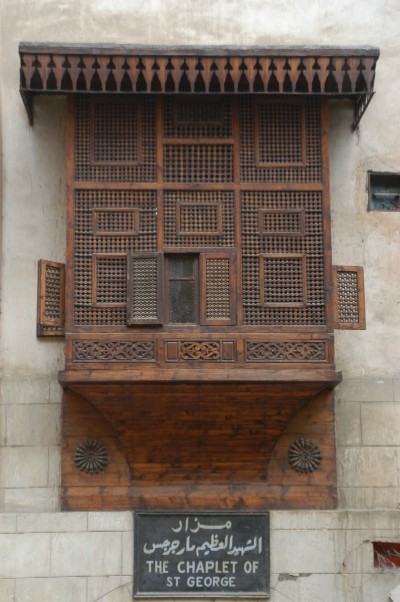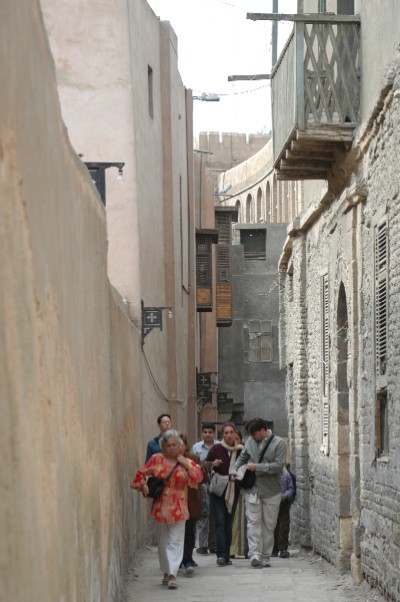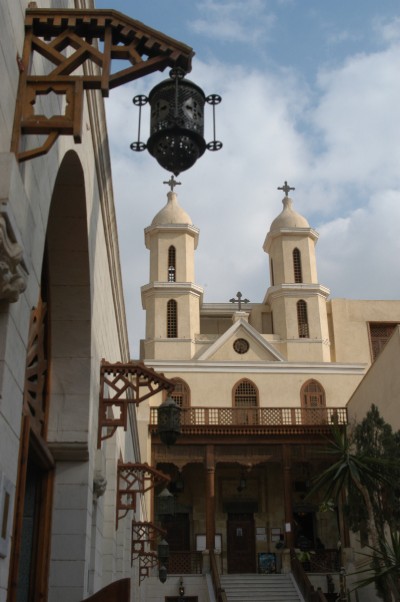March 7. CAIRO "Visiting Coptic Cairo (Old Cairo)" With on two days left in Egypt we were struggling against a loss of momentum. We had another late and long breakfast in the sunny TV room and got sucked into a CNN special on Richard Feynman. We finally headed out of the hotel around noon. It was a pretty nice day. The weather had been cool since we arrived in Cairo which was a  nice surprise. It had been quite warm in the Sinai and was up in the 90's in Cairo only a week before. Our agenda for the day was to explore the Coptic quarter of Cairo, also called Old Cairo. It conveniently worked out that we could reach the area via the subway right next to our hotel. This was our first subway adventure in Cairo and the relatively new and efficient system was unexpectedly incongruous with other forms of transport that we had been in Egypt. A French-Japanese assisted system the subway cars looked like some we had seen in Tokyo and were kept clean. It was a flat 75p to anywhere on the two lines. nice surprise. It had been quite warm in the Sinai and was up in the 90's in Cairo only a week before. Our agenda for the day was to explore the Coptic quarter of Cairo, also called Old Cairo. It conveniently worked out that we could reach the area via the subway right next to our hotel. This was our first subway adventure in Cairo and the relatively new and efficient system was unexpectedly incongruous with other forms of transport that we had been in Egypt. A French-Japanese assisted system the subway cars looked like some we had seen in Tokyo and were kept clean. It was a flat 75p to anywhere on the two lines.
The Copts are an Orthodox Christian minority that originated in Egypt. Today they total about 7 million or just over 10% of the population. Many live in Cairo but Coptic monasteries are still active near the Red Sea coast. The country's oldest monasteries are dedicated to St. Paul and St. Anthony and date back to the beginnings of Christian monasticism. Egypt was also where the Cult of the Virgin and, some argue, the Christian Cross originated. The early Coptic Cross, a cross with a loop at the top, was adopted from the ancient Egyptian ankh or the symbol of the breath of life.
Coptic Christianity differs from Eastern Orthodox and Roman churches over doctrine and ritual. They have their own Pope, that is independent from the Vatican, and their Bible antedates the Latin Bible by a century. They claim to be of purer Egyptian decent since they remained separate at the time of the Arab conquest when most of the country was converted to Islam and they can be identified by the wearing of a cross around their necks or tattoos in the shape of a domed cathedral or cross on their wrists.
When we came out of the subway, which had actually risen above ground in our short journey, we were immediately faced with the compact walled community of Coptic Cairo. We started our tour of the area in the Hanging Church, so named because it hung directly over a water gate. An ornate gate led to a narrow courtyard with stairs up into the church. Another tiny courtyard selling various religious items separated the entrance from the chapel hall. It was a small church with high wooden vaulted ceilings in the shape of upturned arks. Sixteen marble pillars supported the ceiling and the altar areas were beautifully decorated in carved wood with inlaid bone and ivory, similar to the pulpit we had seen at the Mosque of Sultan al-Nasir in the Citadel. Apparently Coptic architecture had notable influence on Islamic architecture and Copts were often employed to build mosques in Egypt. faced with the compact walled community of Coptic Cairo. We started our tour of the area in the Hanging Church, so named because it hung directly over a water gate. An ornate gate led to a narrow courtyard with stairs up into the church. Another tiny courtyard selling various religious items separated the entrance from the chapel hall. It was a small church with high wooden vaulted ceilings in the shape of upturned arks. Sixteen marble pillars supported the ceiling and the altar areas were beautifully decorated in carved wood with inlaid bone and ivory, similar to the pulpit we had seen at the Mosque of Sultan al-Nasir in the Citadel. Apparently Coptic architecture had notable influence on Islamic architecture and Copts were often employed to build mosques in Egypt.
While we were perusing the various items for sale in the courtyard a women approached me with her husband and daughter. I had felt her come up behind me once before to get my attention but my cynical reaction was to think she wanted me to buy something. I felt ashamed when she tapped me once again and asked if I spoke English. When I reluctantly nodded she said that she admired my face and hair very much and proceeded to introduce me to her family. I was stunned and flattered. It was an unexpected compliment from a complete stranger and a women no less. I had become so disgusted by the leering looks and whispered comments from Egyptian men that it felt really nice to have this attractive, well- dressed women pay me such a nice compliment in such a frank way. It had the completely opposite effect and, in a way, it made me feel a bit cleansed of the seedy attention. dressed women pay me such a nice compliment in such a frank way. It had the completely opposite effect and, in a way, it made me feel a bit cleansed of the seedy attention.
After we left the Hanging Church we passed the entrance to the highly recommended Coptic Museum, which was closed for renovation. That was two days in a row! We continued down the street to a courtyard that led into the Monastery of St. George. Just the church was open and the high domed ceiling was completely black except for a image of Christ at the apex. The churches generously allowed photos to be taken so we captured, from a distance, a few people coming in to worship. I was Sunday and the local community was making its rounds to the all of the churches in the quarter. The artwork resembled some features of Greek or Russian Orthodox but had its own style. Gilded wooden frames held tempera on gesso images and enameled lights dangled from the ceiling.
Heading further down the street a small underpass led inside the walled part of the town. The elevation of the street level dropped, showing the neighborhoods age and narrow alleys connected a handful of other churches. The first came upon the Convent of St. George, whose lofty hall once belonged t o a Fatimid mansion and led to a small chapel through tall narrow wooden doors, some 25 feet high. Paritioners were going in and out and we could hear chanting in the tiny naive. It was difficult to peek in but Rob noticed two nuns giving blessing by the entrance and further into the chapel he saw the shackles used in the chain-wrapping ritual, which symbolizes St. George's persecution by the Romans. o a Fatimid mansion and led to a small chapel through tall narrow wooden doors, some 25 feet high. Paritioners were going in and out and we could hear chanting in the tiny naive. It was difficult to peek in but Rob noticed two nuns giving blessing by the entrance and further into the chapel he saw the shackles used in the chain-wrapping ritual, which symbolizes St. George's persecution by the Romans.
The alleyway continued down past a well stocked souvenir market with such pleasant and non-aggressive vendors that you almost wanted to buy something. A bit farther on the alley "T"-ed into another alley and we went right where, at a corner, we found the really old Church of St. Sergius. Its foundation dropped even lower than the already sunk-in level of the neighborhood. It was probably founded in the 5th century but had been and was currently being restored. Much of the interior was covered but as we sat reading our guidebook a young girl passed us with a waive and "hello!". She passed us a couple of more times as she visited the various altars, each time greeting us.
Continuing the procession through town we followed the alleyway to another "T" and entered the Church of St. Barbara just to the left. It wasn't burdened with tour groups and but appeared to be a popular place of worship by the number of local people present. The little girl we had seen in the last church appeared again but this time we noticed the extended family she was with; her mother, sister, father, aunt, two cousins, and uncle. She, her mother and sister had the same unmistakable smile. We sat in a pew to look at the church and they  seated themselves in the pew before us. The older sister talked to us a bit, introducing herself, asking where we were from, and giving us blessings from their God. They were a charming family. They asked if we had children and when we replied not yet they bestowed a small bottle of holy oil on us with a tiny piece of paper with the images of the first Coptic Pope and the current Pope floating inside and a card with a photo of their Pope with a prayer or saying written in Arabic. They gestured that it was for a baby. As we left we found a stairway that led to the rooftop of the church and gave us a nice view of the whole compact area. seated themselves in the pew before us. The older sister talked to us a bit, introducing herself, asking where we were from, and giving us blessings from their God. They were a charming family. They asked if we had children and when we replied not yet they bestowed a small bottle of holy oil on us with a tiny piece of paper with the images of the first Coptic Pope and the current Pope floating inside and a card with a photo of their Pope with a prayer or saying written in Arabic. They gestured that it was for a baby. As we left we found a stairway that led to the rooftop of the church and gave us a nice view of the whole compact area.
Next the Church of St. Barbara stood the restored Ben Ezra Synagogue. Jewish people have lived in Egypt since antiquity but it is predicted that the tiny remaining population will be gone with a decade from emigration. After struggling to maintain itself the synagogue finally benefited from funds from the American Jewish Congress and the Egyptian government and is now beautiful restored. After being wanded for weapons we took a peak at the beautiful inlaid wood work and marble pulpit that dominate the small building.
Retracing our steps back to the first intersection we the other direction to visit the last churches in the quarter. The first, another Church of St. George, founded in 681 by Athanasius the Scribe, looked closed. The last one, the Church of the Virgin, was a newly remodeled building that was larger than all of the rest but lacked any historical charm. And, after a lovely visit to the Coptic area and not encountering one tout the sleazy guy attending this church tried to ask for baksheesh because he turned on the light. Ahhhh! It annoyed us all that much more because he tainted our otherwise perfect experience. experience.
Leaving the walled neighborhood we kept going in the direction away from the metro until we reached the end of the outer wall. There we found a small cafe and ordered some mint tea. The older sister from the family we met stopped at the cafe for water and waived. We strolled back to the metro past a nice row of antique and souvenir shops with a slightly better selection of goods than usual but still didn't find anything we couldn't life without.
Returning to central Cairo we passed our stop and got off at Nasser Station where we searched out a new place to have dinner. The area was bustling with cafes and restaurants but the place we decided on just didn't have the character that came with Cairo's Islamic quarter. The food was good, the staff were friendly, and the nice white table clothes made it seem oddly formal. We walked from the restaurant back down Talat Harb to our hotel. We spent a few hours journaling and reading before going to Groppi's for desert. They had marginal service and our cakes weren't as good as usual but it was a good escape from the hotel room. We had signed up for a day tour to the pyramids the following day so we tried to get to bed before midnight.
|

